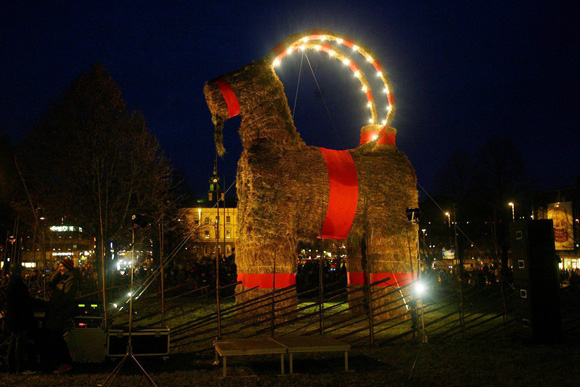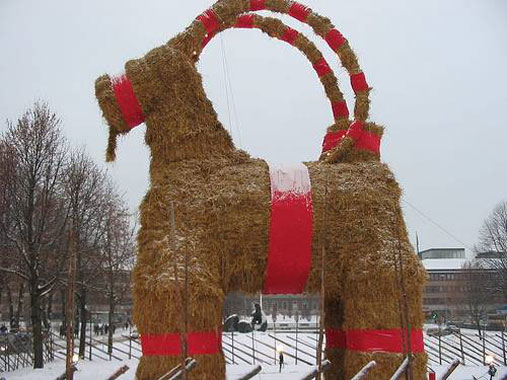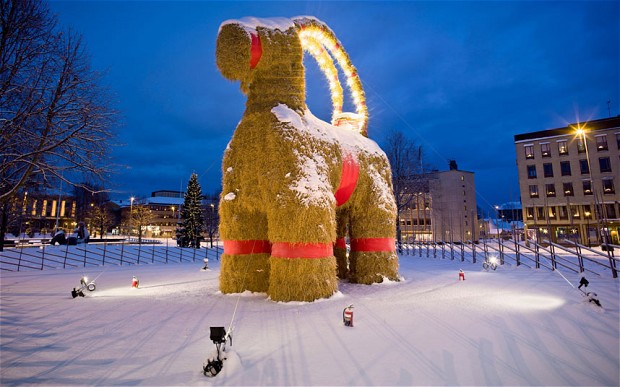The Gävle Goat (Gävlebocken) is a traditional Christmas display erected annually at Slottstorget ("Castle Square") in central Gävle. It is a giant version of a traditional Swedish Yule Goat figure made of straw, and is erected each year at the beginning of Advent over a period of two days by local community groups.
It is notable for being a recurring target for vandalism by arson, and has been destroyed several times since the first goat was erected in 1966.
In 1966, an advertising consultant, Stig Gavlén, came up with the idea of making a giant version of the traditional Swedish Yule Goat and placing it in the square. The design of the first goat was assigned to the then chief of the Gävle fire department, Gavlén's brother Jörgen Gavlén. The construction of the goat was carried out by the fire department, and they erected the goat each year from 1966 to 1970 and from 1986 to 2002.
The first goat was financed by Harry Ström. On 1 December 1966, a 13-metre (43 ft) tall, 7-metre (23 ft) long, 3-tonne goat was erected in the square. On New Year's Eve, the goat was burnt down.
A group of businessmen known as the Southern Merchants (Söders Köpmän) financed the building of the goat in subsequent years, many of which were also subject to arson attacks. In 1971, the Southern Merchants stopped building the goats. The Natural Science Club of the School of Vasa began building the structure. Their goat was around 2 metres (6.6 ft). Due to the positive reaction their Yule Goat received that year, they built another one the following year and from then on. The Natural Science Club's Yule Goat were also burnt and vandalised; one year it was run over by a car.
The Gävle Goat is erected every year on the first day of Advent, which according to Western Christian tradition is in late November or early December, depending on the calendar year. Because the fire station is close to the location of the goat, most of the time the fire can be extinguished before the wooden skeleton is severely damaged. If the goat is burned down before Lucia (feast day of Saint Lucy, 13 December), the goat has been rebuilt. The skeleton is then treated and repaired, and the goat reconstructed over it, using straw which the Goat Committee has pre-ordered.
From 1988 onward, English bookmakers took bets on the goat's survival. In 1996 the Southern Merchants introduced camera surveillance to monitor the goat 24 hours a day. On 27 November 2004 the Gävle Goat's homepage was hacked into and one of the two official webcams changed to display Brinn Bockjävel (translation: "Burn, fucking goat") in the left corner of its live feed. One year, while security guards were posted around the goat in order to prevent further vandalism, the temperature dropped far below zero. As the guards ducked into a nearby restaurant to escape the cold, the vandals struck.
During the weekend of 3–4 December 2005 a series of attacks on public Yule Goats across Sweden were carried out; The Gävle Goat was burnt on 3 December. The Visby goat on Gotland burned down, the Yule Goat in Söderköping, Östergötland was torched, and there was an attack on a goat located in Lycksele, Västerbotten.
The cost for the 1966 goat was SEK 10,000. The price tag for constructing the goat in 2005 was around 100,000 Swedish kronor. The city pays one-third of the cost while the Southern Merchants pay the remaining sum. Since 2003 the construction of the goat has been undertaken by a group of unemployed people (known as ALU workers).
The Christmas season of 2006 marked the 40th anniversary of the Gävle Goat, and, on Sunday 3 December, the city held a large celebration in honor of the goat. The Goat Committee fireproofed the goat with "Fiber ProTector Fireproof", a fireproofing substance that is used in airplanes. In earlier years when the goat had been fireproofed, the dew had made the liquid drip off the goat. To prevent this from happening in 2006, "Fireproof ProTechtor Solvent Base" was applied to the goat. Despite their efforts, the goat has been destroyed a total of 27 times up until the most recent incident on 21 December 2013 where the goat was torched by vandals once again.












